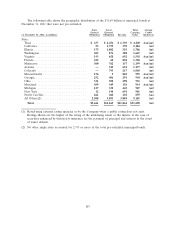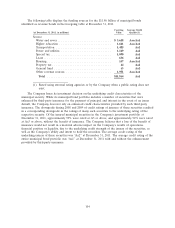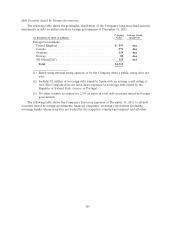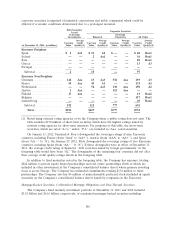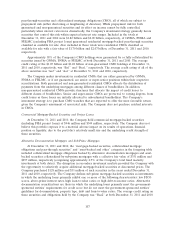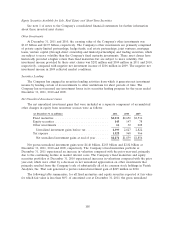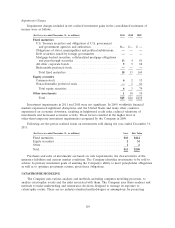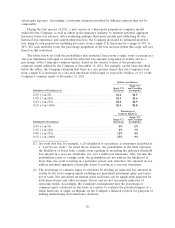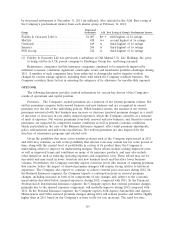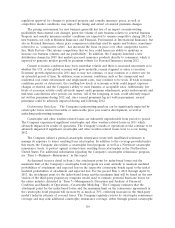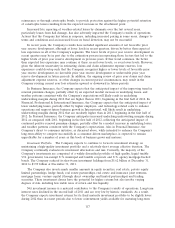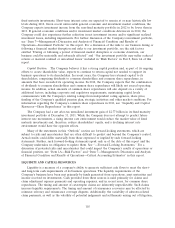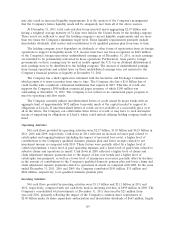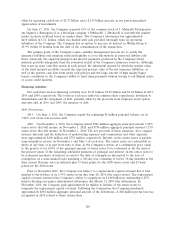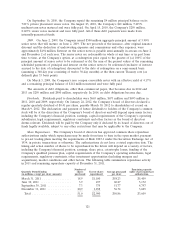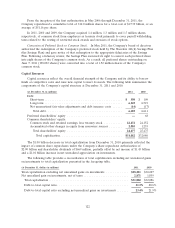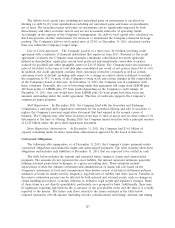Travelers 2011 Annual Report Download - page 125
Download and view the complete annual report
Please find page 125 of the 2011 Travelers annual report below. You can navigate through the pages in the report by either clicking on the pages listed below, or by using the keyword search tool below to find specific information within the annual report.• Changing climate conditions could also impact the creditworthiness of issuers of securities in
which the Company invests. For example, water supply adequacy could impact the
creditworthiness of bond issuers in the Southwestern United States, and more frequent and/or
severe hurricanes could impact the creditworthiness of issuers in the Southeastern United States,
among other areas. See ‘‘Risk Factors—Our investment portfolio may suffer reduced returns or
material realized or unrealized losses.’’
• Increased regulation adopted in response to potential changes in climate conditions may impact
the Company and its customers. For example, state insurance regulation could impact the
Company’s ability to manage property exposures in areas vulnerable to significant climate driven
losses. If the Company is unable to implement risk based pricing, modify policy terms or reduce
exposures to the extent necessary to address rising losses related to catastrophes and smaller
scale weather events (should those increased losses occur), its business may be adversely
affected. See ‘‘Risk Factors—Catastrophe losses could materially and adversely affect our results
of operations, our financial position and/or liquidity, and could adversely impact our ratings, our
ability to raise capital and the availability and cost of reinsurance.’’
• The full range of potential liability exposures related to climate change continues to evolve.
Through the Company’s Emerging Issues Committee and its Committee on Climate, Energy and
the Environment, the Company works with its business units and corporate groups, as
appropriate, to identify and try to assess climate change-related liability issues, which are
continually evolving and often hard to fully evaluate. See ‘‘Risk Factors—The effects of
emerging claim and coverage issues on our business are uncertain.’’
Climate change regulation also could increase the Company’s customers’ costs of doing business.
For example, insureds faced with carbon management regulatory requirements may have less available
capital for investment in loss prevention and safety features which may, over time, increase loss
exposures. Also, increased regulation may result in reduced economic activity, which would decrease
the amount of insurable assets and businesses.
The Company regularly reviews emerging issues, such as changing climate conditions, to consider
potential changes to its modeling and the use of such modeling, as well as to help determine the need
for new underwriting strategies, coverage modifications or new products.
REINSURANCE RECOVERABLES
Ceded reinsurance involves credit risk, except with regard to mandatory pools for which liability is
mostly joint and several, and is generally subject to aggregate loss limits. Although the reinsurer is
liable to the Company to the extent of the reinsurance ceded, the Company remains liable as the direct
insurer on all risks reinsured. Reinsurance recoverables are reported after reductions for known
insolvencies and after allowances for uncollectible amounts. The Company also holds collateral,
including trust agreements, escrow funds and letters of credit, under certain reinsurance agreements.
The Company monitors the financial condition of reinsurers on an ongoing basis and reviews its
reinsurance arrangements periodically. Reinsurers are selected based on their financial condition,
business practices and the price of their product offerings. After reinsurance is purchased, the
Company has limited ability to manage the credit risk to a reinsurer. In addition, in a number of
jurisdictions, particularly the European Union and the United Kingdom, a reinsurer is permitted to
transfer a reinsurance arrangement to another reinsurer, which may be less creditworthy, without a
counterparty’s consent, provided that the transfer has been approved by the applicable regulatory
and/or court authority.
The Company has also entered into Master Security Agreements with certain reinsurers. These
agreements define conditions that require the reinsurer to provide collateral. The specific conditions
and the amounts and form of collateral to be provided by these agreements vary based on a number of
113


